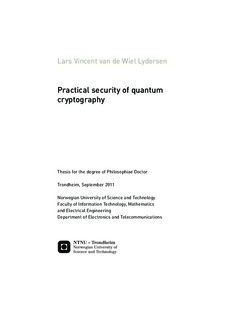| dc.contributor.advisor | Skaar, | nb_NO |
| dc.contributor.advisor | Makarov, | |
| dc.contributor.author | Lydersen, Lars Vincent van de Wiel | nb_NO |
| dc.date.accessioned | 2014-12-19T13:46:43Z | |
| dc.date.accessioned | 2015-12-22T11:45:22Z | |
| dc.date.available | 2014-12-19T13:46:43Z | |
| dc.date.available | 2015-12-22T11:45:22Z | |
| dc.date.created | 2011-09-25 | nb_NO |
| dc.date.issued | 2011 | nb_NO |
| dc.identifier | 443387 | nb_NO |
| dc.identifier.isbn | 978-82-471-3012-4 | nb_NO |
| dc.identifier.uri | http://hdl.handle.net/11250/2370269 | |
| dc.description.abstract | The peculiar properties of quantum mechanics enable possibilities not allowed by classical physics. In particular, two parties can generate a random, secret key at a distance, even though an eavesdropper can do anything permitted by the laws of physics. Measuring the quantum properties of the signals generating the key, would ultimately change them, and thus reveal the eavesdropper’s presence. This exchange of a random, secret key is known as quantum cryptography.
Quantum cryptography can be, and has been proven unconditionally secure using perfect devices. However, when quantum cryptography is implemented, one must use components available with current technology. These are usually imperfect. Although the security of quantum cryptography has been proven for components with certain imperfections, the question remains: can quantum cryptography be implemented in a provable, unconditionally secure way, using components available with current technology? This thesis contains both a theoretical, and an experimental contribution to the answer of this question. On the experimental side, components used in, and complete quantum cryptography systems have been carefully examined for security loopholes. In particular, it turned out that two commercial quantum cryptography systems contained loopholes, which would allow an eavesdropper to capture the full secret key, without exposing her presence. Furthermore, this detector control attack could be implemented with current technology. The attack is applicable against a variety of quantum cryptography implementations and protocols.
The theoretical contribution consists of security proofs for quantum cryptography in a very general setting. Precisely, the security is proven with arbitrary individual imperfections in the source and detectors. These proofs should make it possible to use a wide array of imperfect devices in implementations of quantum cryptography.
Finally, a secure detection scheme is proposed, immune to the detector control attack and compatible with those security proofs. Therefore, if this scheme is implemented correctly, it offers provable security. | nb_NO |
| dc.language | eng | nb_NO |
| dc.publisher | Norges teknisk-naturvitenskapelige universitet, Fakultet for informasjonsteknologi, matematikk og elektroteknikk, Institutt for elektronikk og telekommunikasjon | nb_NO |
| dc.relation.ispartofseries | Doktoravhandlinger ved NTNU, 1503-8181; 2011:227 | nb_NO |
| dc.relation.haspart | Lydersen, Lars; Skaar, Johannes. Security of quantum key distribution with bit and basis dependent detector flaws. Quantum information & computation. (ISSN 1533-7146). 10: 60-76, 2010. | nb_NO |
| dc.relation.haspart | Marøy, Øystein; Lydersen, Lars; Skaar, Johannes. Security of quantum key distribution with arbitrary individual imperfections. Physical Review A. Atomic, Molecular, and Optical Physics. (ISSN 1050-2947). 82(032337), 2010. <a href='http://dx.doi.org/10.1103/PhysRevA.82.032337'>10.1103/PhysRevA.82.032337</a>. | |
| dc.relation.haspart | Lydersen, Lars; Makarov, Vadim; Skaar, Johannes. Secure gated detection scheme for quantum cryptography. Physical Review A. Atomic, Molecular, and Optical Physics. (ISSN 1050-2947). 83: 032306, 2011. <a href='http://dx.doi.org/10.1103/PhysRevA.83.032306'>10.1103/PhysRevA.83.032306</a>. | |
| dc.relation.haspart | Jain, Nitin; Wittmann, Christoffer; Lydersen, Lars; Wiechers, Carlos; Elser, Dominique; Marquardt, Christoph; Makarov, Vadim; Leuchs, Gerd. Device calibration impacts security of quantum key distribution. Physical Review Letters. (ISSN 0031-9007). 107: 110501, 2011. <a href='http://dx.doi.org/10.1103/PhysRevLett.107.110501'>10.1103/PhysRevLett.107.110501</a>. | |
| dc.relation.haspart | Lydersen, Lars; Jain, Nitin; Wittmann, Christoffer; Marøy, Øystein; Skaar, Johannes; Marquardt, Christoph; Makarov, Vadim; Leuchs, Gerd. Superlinear threshold detectors in quantum cryptography. Physical Review A. Atomic, Molecular, and Optical Physics. (ISSN 1050-2947). 84: 032320, 2011. <a href='http://dx.doi.org/10.1103/PhysRevA.84.032320'>10.1103/PhysRevA.84.032320</a>. | |
| dc.title | Practical security of quantum cryptography | nb_NO |
| dc.type | Doctoral thesis | nb_NO |
| dc.contributor.department | Norges teknisk-naturvitenskapelige universitet, Fakultet for informasjonsteknologi, matematikk og elektroteknikk, Institutt for elektronikk og telekommunikasjon | nb_NO |
| dc.description.degree | PhD i elektronikk og telekommunikasjon | nb_NO |
| dc.description.degree | PhD in Electronics and Telecommunication | |


